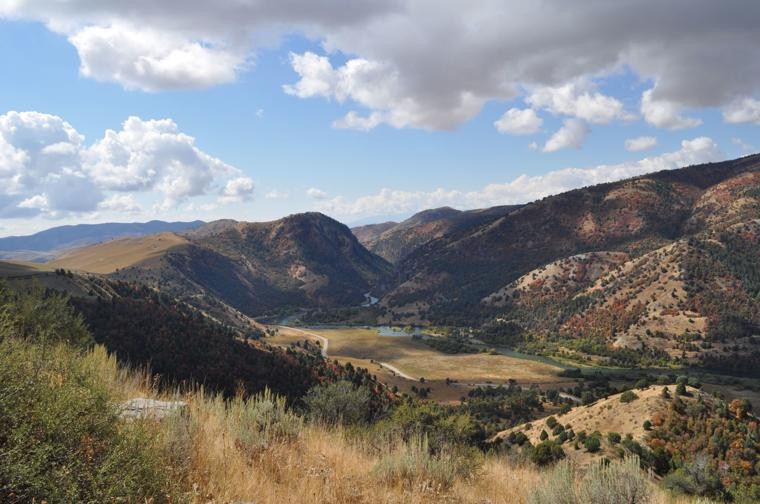POCATELLO — Officials with a local land trust say they hope to use revenue from phosphate mining and hydro-electric power generation to prevent development of important regional wildlife habitat.
The Sagebrush Steppe Land Trust works to preserve key habitat throughout Southeast Idaho’s seven counties, mostly by purchasing development rights of farm and ranch land from willing owners, explained Matt Lucia, who became the nonprofit’s executive director in February 2017.
The land trust has long been a beneficiary of funding provided by PacifiCorp, in compliance with a Federal Energy Regulatory Commission re-licensing settlement requiring the company to mitigate for its Bear River Dam operations through 2033.
Lucia said the land trust has applications pending with the committee that allocates PacifiCorp’s funding, seeking to buy development rights of two agricultural parcels along a major Bear River tributary, Mink Creek.
The Pocatello-based land trust is also poised to apply for some of the $1.2 million earmarked last fall by the former Agrium agricultural company for conservation projects, Lucia said. The land trust has a couple of projects in mind that would involve securing protective easements and hiring a contractor to make wildlife enhancements on habitat within the so-called phosphate patch.
Lucia explained Agrium, now operating as Itafos, voluntarily agreed to offer the funds as a means of offsetting environmental impacts of its new Rasmussen Valley Mine near the headwaters of the Blackfoot River. Lucia said a Habitat Improvement Team composed of state, tribal and federal resource managers will accept proposals for consideration from October through mid-December.
The land trust was tasked by the committee with recruiting other entities to apply for the Agrium funds and building a website with information regarding the application process.
“It’s going to be competitive, and the committee that will select projects hopes to receive applications from a variety of agencies and organizations and will focus on habitat restoration and enhancement,” Lucia said.
Jon Goode, manager of special projects at the Itafos Conda site, said his company’s desire is for the chosen projects to be as close as possible to the new mine, though Itafos doesn’t serve on the selection committee.
“I believe there’s a lot of opportunities for wildlife enhancement in that area,” Goode said.
Goode said his company started mining ore from the new mine early this year. He said the company also made a cash payment of approximately $500,000 to the Idaho Department of Fish and Game to make wildlife enhancements within the Blackfoot Wildlife Management Area it operates in the mining area.
The Bureau of Land Management encouraged such off-site mitigation projects under the Obama administration. Off-site mitigation isn’t a consideration under the agency’s current policy.
Nonetheless, Jeff Cundick, minerals branch chief with the BLM in Pocatello, believes offering conservation funding is a “phenomenal way wildlife may benefit from phosphate mining.”
“We were able to look in our environmental impact statement to show basically when you calculate everything Agrium put together, there was going to be no residual effect to wildlife habitat,” Cundick said.
Lucia admits he’s “wrestled” with the idea of accepting money from extractive industries. But he reasons mines and dams will continue operating, and it’s in everyone’s best interests to help them offset their effects on the environment.
“I know there are critics,” Lucia said.
Regarding the planned Mink Creek projects along the Bear River, Lucia said one parcel encompasses 500 acres, and the farmer and rancher who owns the land has expressed a willingness to also participate in wildlife enhancement work. He said it’s too early to offer details of the second parcel.
“Both properties have tremendous conservation value for fish and wildlife, particularly Bonneville cutthroat trout,” Lucia said.
The land trust received its nonprofit status in 2004. It currently holds 25 conservation easements and owns three properties outright, protecting a total of 5,500 acres from development. Lucia said 18 of those easements are located along the Bear River, where PacifiCorps settlement dollars may be invested.
The land trust updated its strategic plan at the start of this year, emphasizing the need to branch out from the Bear River corridor into a broader area. Lucia said the plan sets specific goals for individual service areas, based on watersheds. He said the land trust has eight projects currently in the works throughout the seven counties.
Partnerships with other nonprofits and governmental entities are vital to the land trust’s success, Lucia said. He said the land trust completed the first phase of a major project in partnership with the U.S. Forest Service, USDA’s Natural Resources Conservation Service, the Governor’s Office of Species Conservation and the Idaho Department of Fish and Game, which restored a channelized stretch of Deep Creek through the Curlew National Grassland near Malad.
Work on the second phase of the project — which will restore a lengthy channelized stretch of Rock Creek, thereby bringing back “natural processes” in the adjacent floodplain — will commence within a couple of weeks within the Curlew.
The land trust has scheduled a 6-mile hike to showcase one of its conservation easements, located within Oneida Canyon. Participants will gather at 7:45 a.m. Saturday at the land trust office in Pocatello, 109 N. Arthur Ave., Suite 300. The group will leave at 8 a.m. and return at 5 p.m.



